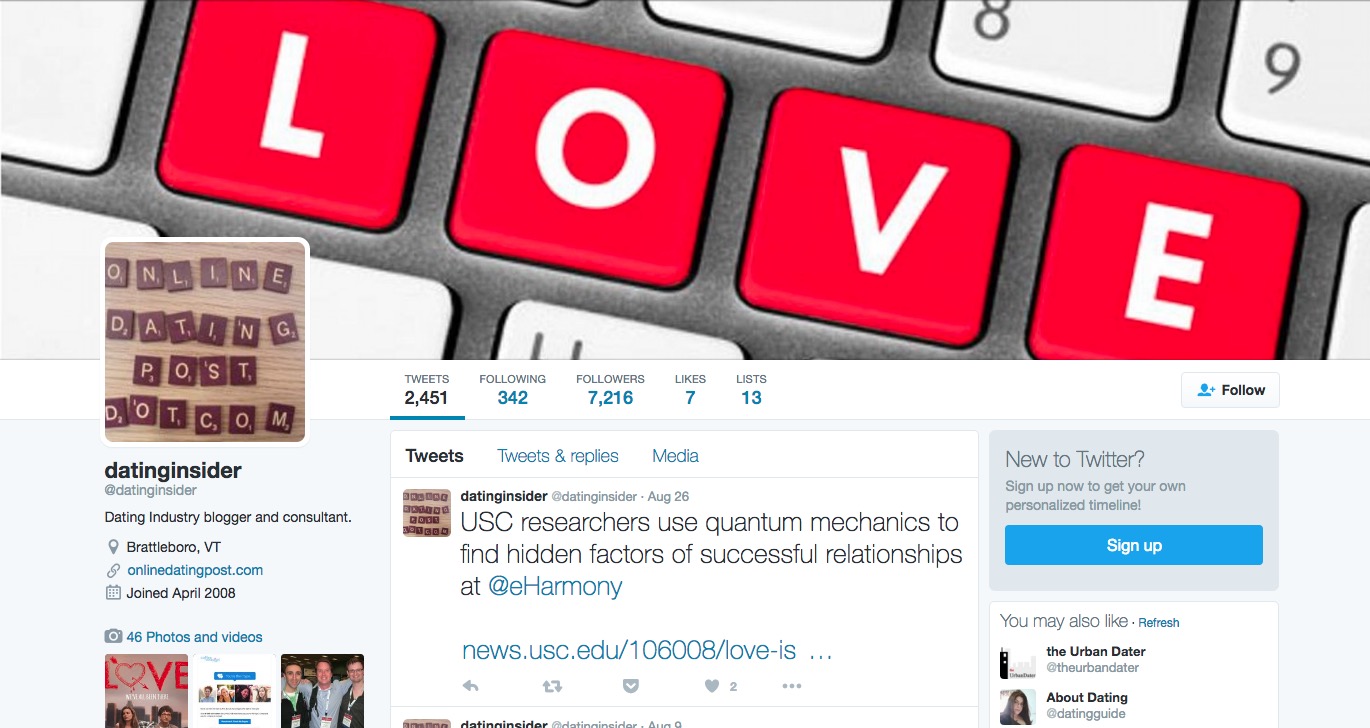Today’s New York Times has an article about The Dubious Science of Online Dating. While I was reading it, Markus Frind, founder of Plentyoffish (recently rebranded as POF), sent me ELI J. FINKEL AND BENJAMIN R. KARNEY are wrong at least when it comes to POF. Markus was responding to a research report by Eli Finkel, Associate Professor of Social Psychology at Northwestern University, that says dating site matching systems are Doing It Wrong. Read the full report here (PDF). Markus feels that POF is doing things with matching that the dating industry doesn’t even think is possible. I can’t comment on that claim, but every single person on the planet should be glad he’s made it. Perhaps we are witnessing the point in time where the dating industry, with prodding from academics, the media, and singles, starts to realize how important matching systems really are. Not to mention how a great matching system can reduce customer acquisition costs and churn, and perhaps get some of those 70 million US singles not on dating sites to try online dating.
As Sam Yagan of OKCupid told me once (paraphrasing), a good matching algorithm isn’t only about making great matches, its also about hiding the people from you that you don’t want to see on the site.
The online dating industry has generally been focused on marketing for a decade. Now, the industry is being forced to acknowledge that the playing field has shifted to the matching algorithms used to put quality people in front of each other . Game on!
But first, lets take a step back and look at a decade of online matchmaking. For the early part of the decade the algorithms matching people were, how can I say this politely, less than useful. For the majority of sites, matching on anything more complicated than age/sex/location was a shot in the dark. EHarmony was the first site to bring psychology into the mix. EHarmony, which has from day one put its reputation on the line as the number one site for quality matches, was just starting to figure out what they had gotten themselves into with their 240-question signup process. (Sidebar: I wonder what the minimum number of questions will be to make a successful match, or will matches be based more on behavior, or something completely different?)
Along came OkCupid, which was quietly building a system based on ascertaining compatibility based on its social questions features (and I’m sure a lot of other proprietary magic pixie dust). Singles appreciated the nature of the questions, which were fun, and most importantly, social. No big long tests, results hidden away in some database. You answered a question, and could make that answer public. Exposing and leveraging people’s answers to questions about their personal beliefs in a way that no other dating site was doing at the time. Brilliant. OKCupid was the first site that made dating more social, just not in the way the latest crop of sites is doing it (friends matching friends via Facebook social graph).
Around this time, dating site started realizing that trying to match people together from a pool of 5 million people was a considerable challenge. If there are 5,000 singles in a major metropolitan area, how in the world were they going to show you the handful of people that might be a quality match? This wasn’t so much of a problem for smaller areas, because sooner or later you’re going to see everyone around you, and the thinking was “let the customer figure it out.” I don’t blame them, matching people on a dating site is an incredibly complex undertaking.
The online dating industry is still in the Paleolithic era. They are just starting to figure out how to take your profile, your test and question results and your behavior into consideration while building matching systems. Figuring out what kind of car to buy on Cars.com is straightforward, but us humans are messy bags of flesh, full of ego, bias and emotional detritus that makes the job of pairing us up with life partners (and to some extent one-night stands) seemingly impossible. Just ask any jaded online dater.
I’m not going to compare matching systems here, because there is absolutely no way to compare the effectiveness of dating sites. The methodology of measurement is flawed, the sample sizes are flawed and the folllow-up process isn’t stringent enough to warrant a serious discussion about whether or not say a POF or a Match or an eHarmony are “better” dating sites. Better for what? One-night stands? Long-term relationships? Casual dating? Dating sites may have this data internally, but until now they sure haven’t wanted you to know about it.
Markus has a chart in his blog post showing how many people are in successful relationships after meeting on POF. the caveat here is that the people left the site and never came back, which doesn’t take into consideration that the people might have gone to another dating site. See, messy.
Talking about big top-10 dating sites is one thing, but what about the white label dating services, which deploy, host, run and manage tens of thousands of dating sites? Nobody seems to ever question the matching algorithms on these sites. The focus has been on the speed and simplicity of getting a dating site up and running in a matter of days. Turn on the revenue spigot and go, go, go.
Same goes for niche sites. Match bought People Media and their suite of niche sites for $90 million dollars. Spark Networks falls into this category as well, although JDate is considered the grown jewel of the Spark empire. The idea behind these niche site networks was to build a dating platform and then roll out multiple sites by cloning the look and feel and tailor the graphics for each specific niche (mature, asian, Christian, Jewish, black, etc.). But nobody ever talks about how they match people up, everyone was so excited that there was a site for them, because they didn’t want to be lost in a sea of millions of generic singles.
Further, we have the “dating site in a box” vendors like SkaDate and Boonex (disclaimer: you’ll see their ads in the sidebar on this blog.) What is their matching system based on? Most dating site entrepreneurs didn’t worry to much about the matching system. It was all about getting up and running quickly on a site where they controlled how the site functioned, and more importantly, keeping all of the revenue. Remember, white label dating providers take anywhere from 25-70% of a sites’ revenue in return for managing the site.
Lets not forget Chemistry.com, Match’s answer to eHarmony. Dr. Helen Fisher and her group at Chemistry have worked for years on a matching system that purports to be more efficient and effective than other dating site. But do we really know if Chemistry matches people better than the competition? Chemistry, like all big dating sites, has spent tens of millions on marketing, because as I said, dating site superiority has been a marketing exercise for the better part of the decade.
I have a folder full of research pertaining to compatibility matching. I talk to Very Smart People all the time about psychology tests and deep math, none of which I claim to understand at more than a superficial level. What I do know is that dating site rankings based on traffic alone are useless, and its been a popularity contest until now. If you don’t have quality singles in my area code, it doesn’t matter how large you are. Maybe someday dating sites will use heat-maps to show the density of their users based on a specific location, but I’m not holding my breath.
In the last year or so, dating sites have started to announce the number of successful relationships started on sites, ranging from 3-months in duration to marriage. This is a Good Thing and a step in the right direction.
I wonder how long dating site marriages last compared to meeting someone through friends, a bar, church, etc.? This is a good start, but it still smells to my like a variation of How to Lie With Maps, who’s author wanted to “make readers aware that maps, like speeches and paintings, are authored collections of information and also are also subject to distortions arising from ignorance, greed, ideological blindness, or malice.”
Getting the online dating industry to move the battle towards effective matching is good news for all parties involved and I am excited to see how this all plays out. There are also many new dating startups trying out new matching systems which I hope will play an important role in forcing the dating industry to step up its game.
To see what POF has learned (love their transparency!), you should definitely go read Markus’ post, its a good one and sure to fire up a lot of people, dating industry insiders and singles alike.

